Earth's Mineral Resources: Formation, Plate Tectonics, and Rock Cycle
1/99
There's no tags or description
Looks like no tags are added yet.
Name | Mastery | Learn | Test | Matching | Spaced |
|---|
No study sessions yet.
100 Terms
Mineral Resources
Almost all of the mineral resources on Earth accumulated when the planet formed 4.6 billion years ago.
Geologic Processes
Earth's geologic processes form and break down rocks and minerals, drive volcanic eruptions and earthquakes, determine the distribution of scarce mineral resources, and create the soil in which plants grow.
Geologic Time Scale
Earth's history is measured using the geologic time scale.
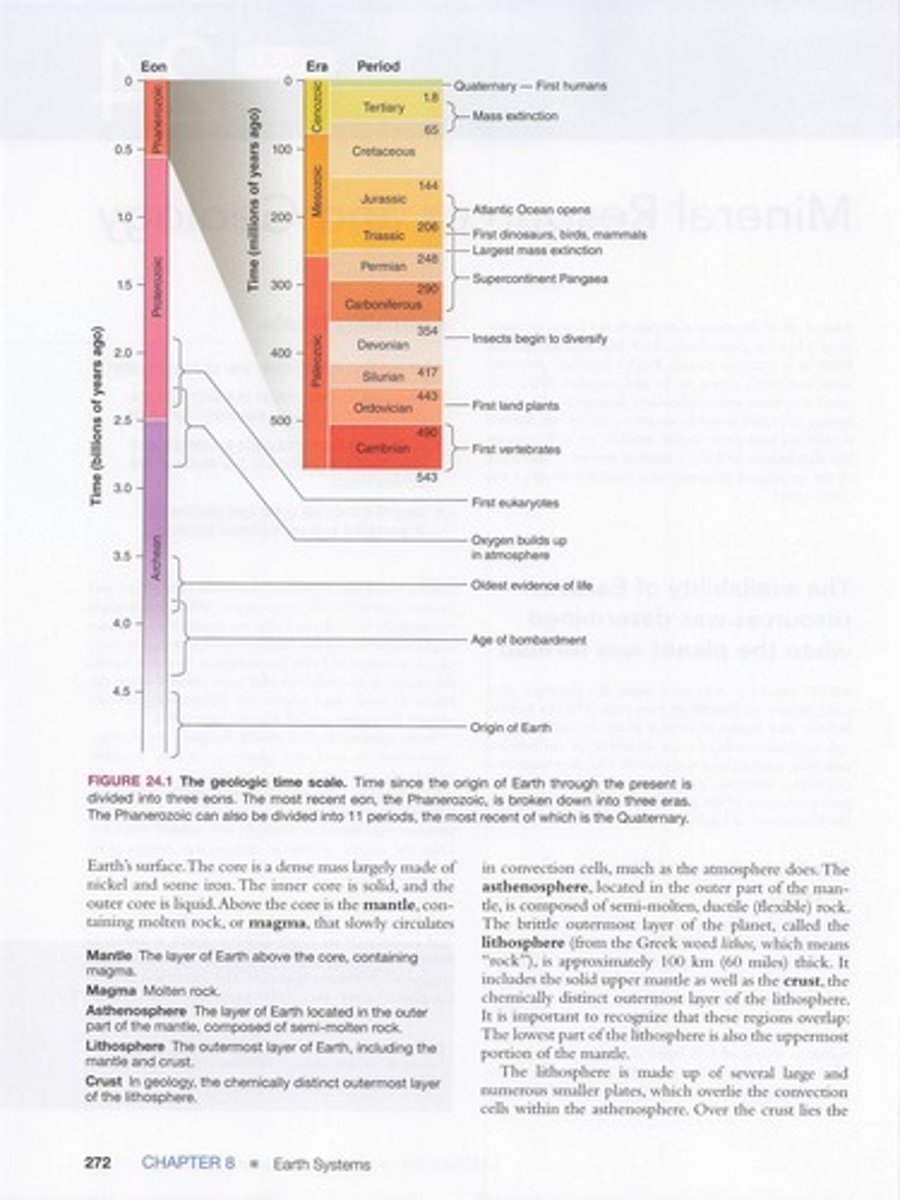
Formation of Earth
Earth formed roughly 4.6 billion years ago from cosmic dust in the solar system.
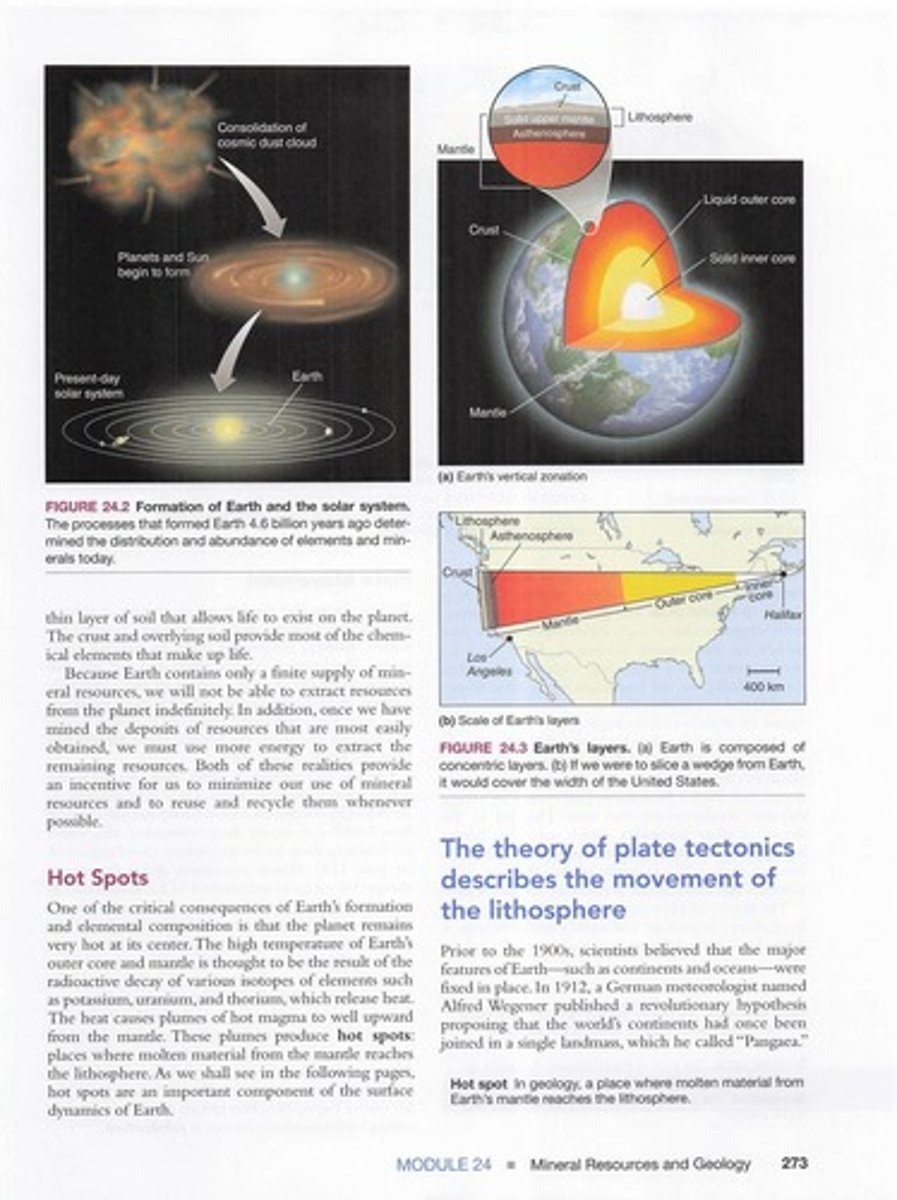
Early Earth
The early Earth was a hot, molten sphere.
Elemental Composition
The elemental composition of Earth has stabilized since the bombardment phase of planet formation has largely ceased.
Vertical Zonation
The planet is characterized by distinct vertical zonation due to the settling of elements according to their mass.
Core
The innermost zone of Earth's interior, composed mostly of iron and nickel, includes a liquid outer layer and a solid inner layer.
Silicon Dioxide
Silicon dioxide is the primary component of sand and glass and is readily available worldwide on beaches and in shallow marine and glacial deposits.
Diamonds
Diamonds are formed from carbon that has been subjected to intense pressure and are found in relatively few isolated locations.
Economic and Political Conflicts
The uneven geographic distribution of minerals has driven many economic and political conflicts throughout human history.
Cosmic Dust
Earth formed from cosmic dust in the solar system.
Asteroids
Asteroids occasionally strike Earth today, but the bombardment phase of planet formation has largely ceased.
Concentric Layers
If we could slice into Earth, we would see concentric layers composed of various materials.
Geological Processes
Geological processes continue to affect the distribution of Earth's mineral resources.
Scarce Mineral Resources
The distribution of scarce mineral resources is influenced by Earth's geologic processes.
First Humans
The Quaternary period marks the time of the first humans.
Mass Extinction
The Cretaceous period is known for the largest mass extinction.
Pangaea
The supercontinent Pangaea existed during the Jurassic period.
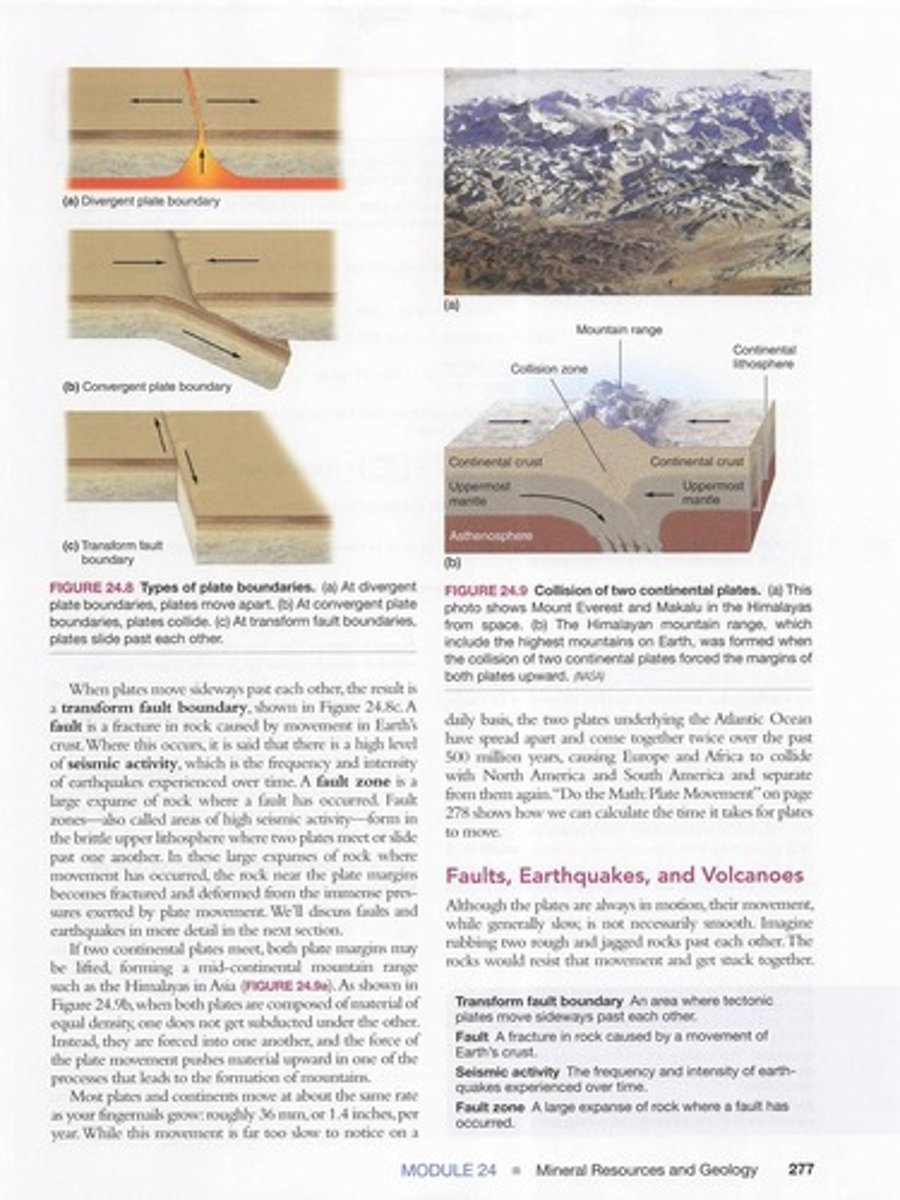
First Dinosaurs
The Triassic period is known for the first dinosaurs, birds, and mammals.
First Land Plants
The Ordovician period is marked by the appearance of the first land plants.
First Vertebrates
The Cambrian period is known for the first vertebrates.
Oxygen in Atmosphere
The Archean eon is characterized by the buildup of oxygen in the atmosphere.
Oldest Evidence of Life
The Archean eon also contains the oldest evidence of life.
Age of Bombardment
The age of bombardment refers to the period when debris from the formation of the Sun bombarded Earth.
Mantle
The layer of Earth above the core, containing molten rock, or magma.
Magma
Molten rock.
Asthenosphere
The layer of Earth located in the outer part of the mantle, composed of semi-molten rock.
Lithosphere
The outermost layer of Earth, including the mantle and crust.
Crust
In geology, the chemically distinct outermost layer of the lithosphere.
Thickness of Lithosphere
Approximately 100 km (60 miles) thick.
Convection Cells
Processes in which the mantle circulates, much like the atmosphere.
Hot Spots
Places where molten material from the mantle reaches the lithosphere.
Finite Mineral Resources
Earth contains only a finite supply of mineral resources, which cannot be extracted indefinitely.
Radioactive Decay
The process by which isotopes of elements such as potassium, uranium, and thorium release heat.
Fossil Evidence
Fossils of the freshwater reptile Mesosaurus have been found in South America and Africa.
Identical Rock Formations
Rock formations that are found on both sides of the Atlantic Ocean, indicating that current landmasses were once joined.
Upper Mantle
The solid upper portion of the mantle that is part of the lithosphere.
Brittle Outermost Layer
The lithosphere, which is the brittle outer layer of the planet.
Chemical Elements for Life
The crust and overlying soil provide most of the chemical elements that make up life.
Energy for Resource Extraction
Once easily obtained mineral resources are mined, more energy is required to extract remaining resources.
Surface Dynamics of Earth
Hot spots are an important component of the surface dynamics of Earth.
Concentric Layers of Earth
Earth is composed of concentric layers, including the core, mantle, and crust.
Supercontinent
A single large continent that may have existed in the past.
Plate Tectonics
The theory that the lithosphere of Earth is divided into plates, most of which are in constant motion.
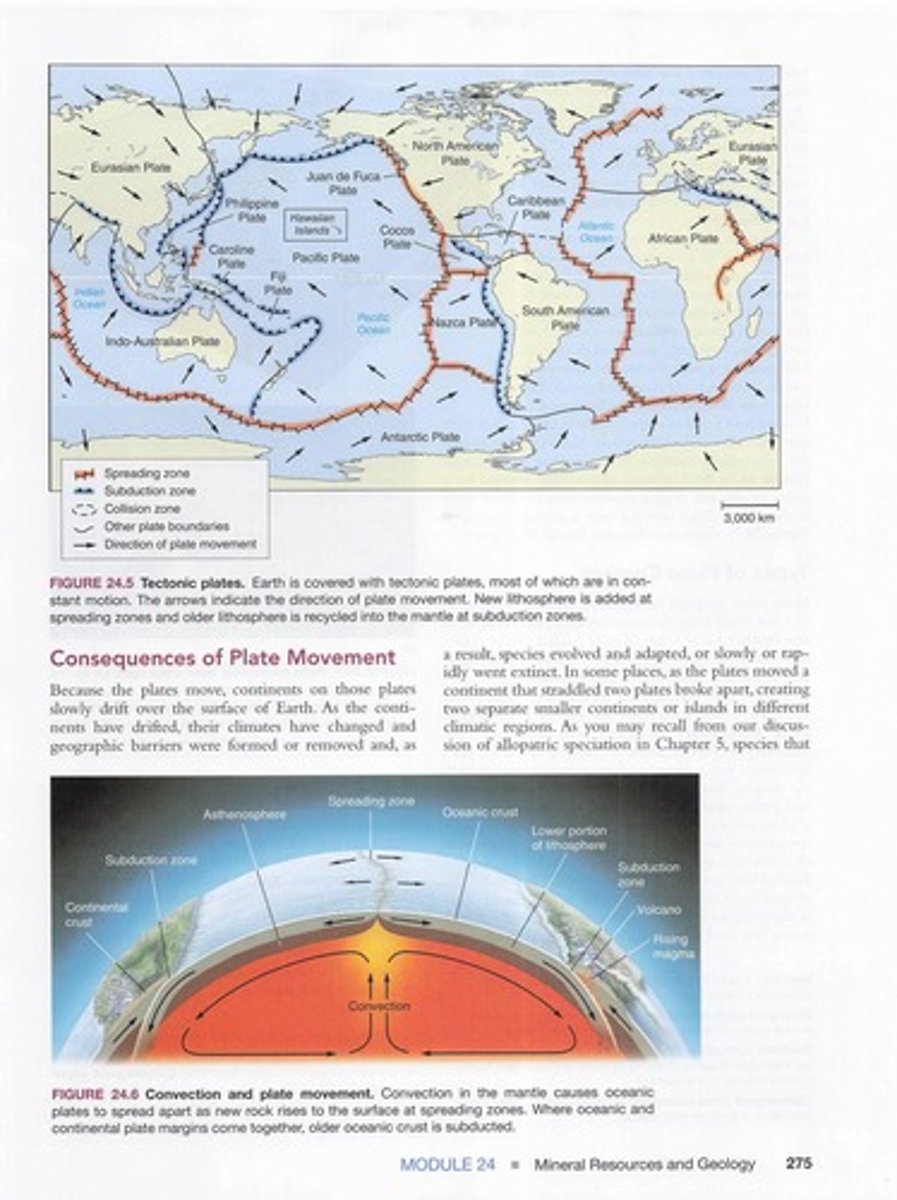
Tectonic Cycle
The sum of the processes that build up and break down the lithosphere.
Subduction
The process of one crustal plate passing under another.
Oceanic Plates
Plates that lie primarily beneath the oceans and have a dense crust rich in iron.
Continental Plates
Plates that lie beneath landmasses and generally contain more silicon dioxide.
Mantle Convection
The process driven by heat from Earth's core that creates convection cells in the mantle.
Seafloor Spreading
The process where rising magma forms new oceanic crust on the seafloor at the boundaries between oceanic plates.
Plate Movement
The slow drift of continents on tectonic plates over the surface of Earth.
Geographic Barriers
Obstacles formed or removed due to plate movement, affecting species evolution.
Eurasian Plate
One of Earth's major tectonic plates.
Indian Plate
One of Earth's major tectonic plates.
North American Plate
One of Earth's major tectonic plates.
Pacific Plate
One of Earth's major tectonic plates.
Nazca Plate
One of Earth's major tectonic plates.
South American Plate
One of Earth's major tectonic plates.
Antarctic Plate
One of Earth's major tectonic plates.
Caribbean Plate
One of Earth's major tectonic plates.
Philippine Plate
One of Earth's major tectonic plates.
Cocos Plate
One of Earth's major tectonic plates.
Fiji Plate
One of Earth's major tectonic plates.
Indo-Australian Plate
One of Earth's major tectonic plates.
Collision Zone
A type of plate boundary where two plates collide.
Spreading Zone
A type of plate boundary where new lithosphere is added.
Subduction Zone
A type of plate boundary where older lithosphere is recycled into the mantle.
Continental crust
The thick part of the Earth's crust that forms the continents.
Oceanic crust
The thin part of the Earth's crust that underlies the oceans.
Lower portion of lithosphere
The rigid outer layer of the Earth, consisting of the crust and upper mantle.
Volcano
A vent in Earth's surface that emits ash, gases, or molten lava.
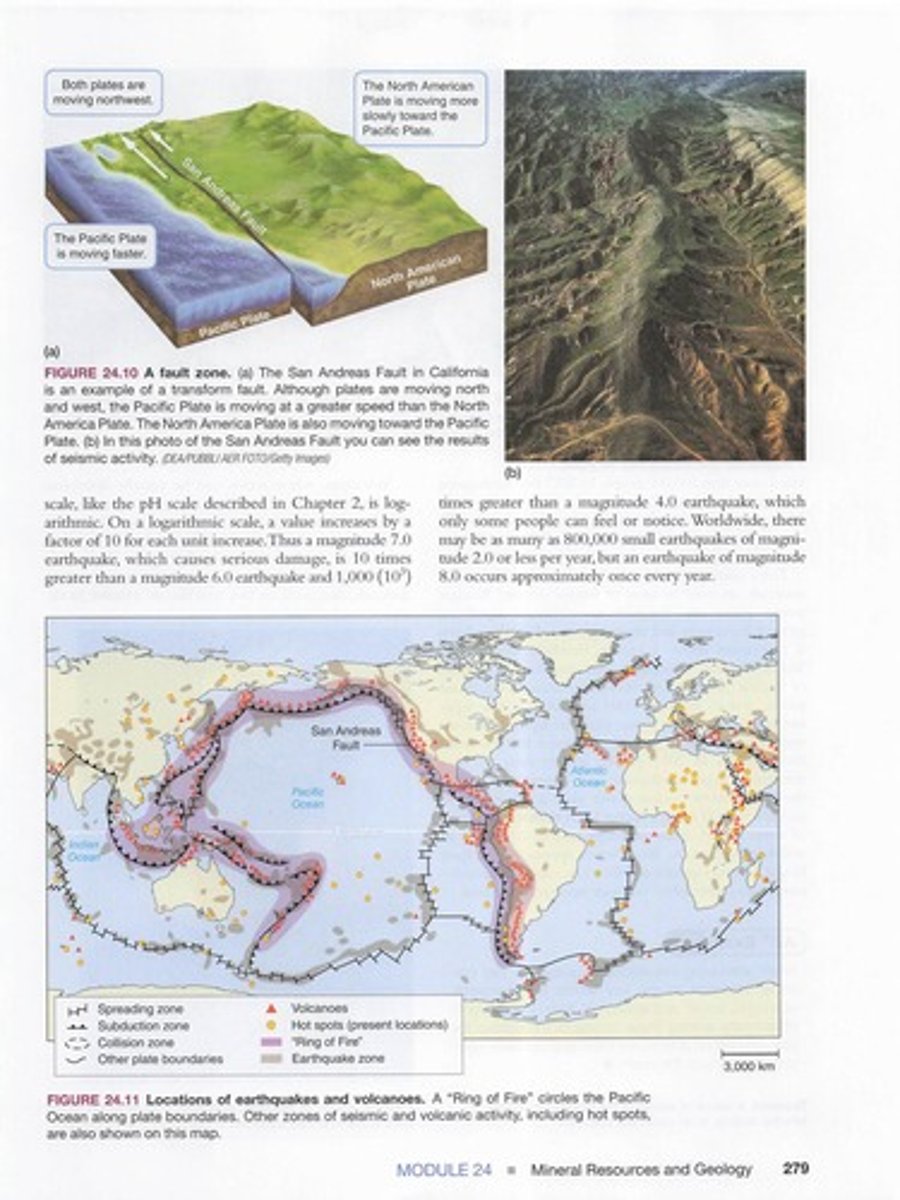
Rising magma
Magma that moves upward from the mantle to the Earth's surface.
Convection
The process by which heat is transferred through the movement of fluids, causing tectonic plate movement.
Divergent plate boundary
An area beneath the ocean where tectonic plates move away from each other.
Convergent plate boundary
An area where plates move toward one another and collide.
Transform fault boundary
A type of fault where two tectonic plates slide past each other horizontally.
Geologic hot spot
A location where magma from the mantle rises to the surface, creating volcanic activity.
Hawaiian Islands
An example of a series of volcanic islands formed by a hot spot as the Pacific Plate moved over it.
Earthquakes
Sudden shaking of the ground caused by the movement of tectonic plates.
Volcanic eruptions
The release of ash, gases, and molten lava from a volcano.
Magma reservoir
An underground pool of molten rock beneath the Earth's surface.
Chemical composition
The specific arrangement and types of elements that make up a substance.
Natural source of atmospheric carbon dioxide
Volcanoes, which emit carbon dioxide during eruptions.
Convergent plate boundaries
Boundaries form where plates move toward one another and collide.
Divergent plate boundaries
Boundaries where plates move apart.
Transform fault boundaries
An area where tectonic plates move sideways past each other.
Fault
A fracture in rock caused by movement in Earth's crust.
Seismic activity
The frequency and intensity of earthquakes experienced over time.
Fault zone
A large expanse of rock where a fault has occurred.
Mid-continental mountain range
Formed when two continental plates meet and both plate margins may be lifted.
Himalayas
A mountain range formed from the collision of two continental plates.
Rate of plate movement
Most plates and continents move at about 36 mm, or 1.4 inches, per year.
Plate Movement Calculation
To calculate the time it takes for plates to move, use the formula: time = distance ÷ rate.
Distance traveled for Los Angeles to San Francisco
The distance is 630 km (or 630,000,000 mm).
Net distance moved for Los Angeles
The plate under Los Angeles is moving northward at about 36 mm per year.
Time for Los Angeles to be adjacent to San Francisco
It will take 17,500,000 years.
Brittle upper lithosphere
Where fault zones form as two plates meet or slide past one another.
Fractured and deformed rock
Occurs in large expanses of rock where movement has occurred due to immense pressures from plate movement.
Earthquake frequency
Measured over time as part of seismic activity.